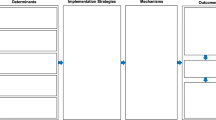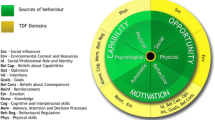Abstract
Objectives: To explore the implementation of patient oriented activities, the perception of an innovation aimed at implementation of patient education and the preconditions for implementation of this innovation among Dutch pharmacists.Method: A survey, based on Rogers' theory of diffusion of innovations, was carried out among a random sample (n = 300) of Dutch managing pharmacists.Main outcome measures: Reported activities regarding patient education, medication surveillance and drug therapy meetings, as well as perception of the innovation and its perceived compatibility with pharmacy practice.Results: The response rate was 49.3%. Hundred (84.7%) respondents reported to provide extra written and verbal information with first prescription medication. Medication surveillance (100% check by computer, and check of the lists by the pharmacist) was reported by 43 (36.4%), and complete participation in drug therapy meetings was reported by 57 (48.3%) respondents. Observability (of results to others) of the new strategy was perceived as important by 90 (77.6%), compatibility (perceived consistency with existing values, past experiences and needs of potential adopters) by 87 (76.4%) and trialability (degree to which an innovation may be experimented with) by 81 (69.8%) respondents. Relative advantages (perception of the innovation as being better) and complexity (relatively difficult to understand and use) of the innovation were perceived as important by less respondents. The preconditions that were met by most pharmacists were 'financial resources' (n = 70; 59.8%), 'enough workspace' (n = 61; 53.1%) and 'enough time' (n = 58; 50%). Fifty-eight (49.2%) respondents intend to adopt the innovation, but this intention would be higher when more time and money and technicians are available, as well as less situations that are experienced as barriers (rush hours, lack of support, illness of employees).Conclusion: Based on the definitions used, we conclude that the implementation of medication surveillance and drug therapy meetings is relatively low compared to patient education. The development of an implementation tool is justified, but should deal with the experienced preconditions, barriers and needs of pharmacists. Combined, comprehensive pharmacy interventions promise to be a good way to change pharmacy practice.
Similar content being viewed by others
References
Van der Heide H, Tinke JL. Facts and figures 1999; Cost development of pharmaceutical aid. The Hague: Foundation for Pharmaceutical Statistics; 1999.
Cancrinus-Matthijsse A. Tussen hulpverlening en ondernemerschap. Beroepsuitoefening en taakopvattingen van openbare apothekers in een aantal West-Europese landen [Dissertation]. Amsterdam: Thesis Publishers, 1995. ISBN 90-5170-393-7.
Van Mil J, De Jong-van den Berg LTW, Tromp TFJ. Pharmaceutical care in the community pharmacy in the Netherlands. Pharmacy in the Netherlands, 1998 (special issue Pharm Weekbl 1998):36-9.
Hepler CD, Strand LM. Opportunities and responsibilities in pharmaceutical care. Am J Hosp Pharm 1990;47(3):533-43.
Tann J, Blenkinsopp A, Allen J, Platts A. Leading edge practitioners in community pharmacy: approaches to innovation. Int J Pharm Pract 1996;4(4):235-45.
Hassell K, Noyce PR, Rogers A. Review of factors that influence the use of community pharmacies as a primary health care resource. Int J Pharm Pract 1999;7(1):51-9.
Bond C, Matheson C, Williams S, Williams P, Donnan P. Repeat prescribing: a role for community pharmacists in controlling and monitoring repeat prescriptions. Br J Gen Pract 2000;50(453):271-5.
Reebye R, Avery AJ, Van den Bosch WJHM, Aslam M, Nijholt A, Van der Bij A. Exploring community pharmacists' perceptions of their professional relationships with physicians, in Canada and the Netherlands. Int J Pharm Pract 1999;7(3):149-58.
Adu A, Simpson JM, Armour CL. Pharmacists' and physicians' perception of antibiotic policies in New South Wales public hospitals. Int J Pharm Pract 2001;9(1):31-6.
Claesson S, Morrison A, Werheimer AI, Berger ML. Compliance with prescribed drugs: challenges for the elderly population. Pharm World Sci 1999;21(6):256-9.
De Jong-Van den Berg L, Van der Zee AH, Schaafsma E, De smit D, Anderson C, Cornel MC. Counseling women about periconceptional use of folic acid: the role of the community pharmacist can be improved. Int J Pharm Pract 1999;7(3):138-42.
Krska J, Duffus PRS. Pharmaceutical needs assessment in general practice. Int J Pharm Pract 2000;8(4):265-74.
Jones J, Matheson C, Bond C. Patient satisfaction with a community pharmacist-managed system of repeat prescribing. Int J Pharm Pract 2000;8(4):291-7.
Lipowsky E. Evaluating the outcomes of pharmaceutical care. J Am Pharm Ass 1996; NS36(12):726-34.
Narhi U, Airaksinen M, Enlund H. Do asthma patients receive sufficient information to monitor their disease-a nationwide survey in Finland. Pharm World Sci 2001;23(6):242-5.
Johnson KA, Parker JP, McCombs JS, Cody M. The Kaiser Permanente/USC Patient Consultation Study: patient satisfaction with pharmaceutical services. University of Southern California. Am J Health Syst Pharm 1998;55(24):2621-9.
Schommer JC, Wiederholt JB. A field investigation of participant and environment effects on pharmacist-patient communication in community pharmacies. Med Care 1995;33(6):567-84.
Schommer JC. Higher levels of consultation services increase patient satisfaction. Am Pharm 1995;NS35(8):33-9.
De Vries C. Collaboration in Healthcare: The tango to drug safety [Dissertation]. Groningen: C.S. de Vries;1998. ISBN 90-367-0978-4.
Paes A. Pharmacy and therapeutic committees in the Netherlands. In: Bakker A, Hekster YA, Leufkens HG (eds) Drug consumption in the Netherlands, Noordwijk: Amsterdam Medical Press, 1997.
Pronk M, Blom L, Jonkers R, Bakker A. Community pharmacy and patient-oriented activities: the Dutch case. Patient Educ Couns 2002;46(1):39-45.
Paes AHP. Contacts between pharmacists and general practitioners in the Netherlands. J Soc Admin Pharm 1983;1:139-43.
Blom ATG, Paes AHP, Bakker A, Koopman CJ, Van der Meer C. Pharmacist physician co-operation at a regional level. Pharm World Sci 1994;16(1):13-7.
Van Dijk L, Barnhoorn H, De Bakker D. Het Farmaco therapie overleg in 1999; stand van zaken en effecten op voorschrijven. Utrecht: Nivel, 2001. ISBN 90-6905-526-0.
Blom A, Kam AL, Bakker A, Claesson C. Patient counselling in community pharmacy. A comparative study between Swedish and Dutch pharmacists. J Soc Adm Pharm 1993;10(2):53-62.
Blom LThG. Developing patient education in community pharmacy [Dissertation]. Utrecht: L.Th.G. Blom; 1996. ISBN 90-393-1492-6.
Van Mil JWF. Pharmaceutical Care, the Future of Pharmacy. Theory, research and practice [Dissertation]. Groningen: J.W.F. van Mil; 2000. ISBN 90-9013367-4.
Kerssens J. Andela MG, Friele RD. Apotheek scoort naar oordeel patient beter in bejegening dan in informatieverschaffing (Pharmacy is judged by patients to be better in treating patients than in providing information). Pharm Weekbl 1997;132(38):1432-9.
Blom A, De Jong JGAM, Sierens J. Klantbejegening in de apotheek. Visie en ervaringen van klanten [Treating clients in the pharmacy. Vision and experiences of clients]. Utrecht: Universiteit Utrecht, Faculteit Farmacie, 1995.
Lelie-Van der Zande A. Resultaten van de Zelfzorgmonitor 1997/1998. Heeft u een goed middel voor de maag? [Results of the Selfcaremonitor 1997/1998. Do you have a good medicine for the stomach?]. Pharm Weekbl 1998;133(44): 1647-53.
Pronk MCM, Blom AThG, Jonkers R, Van Burg A. The diffusion process of patient education in Dutch community pharmacy: an exploration. Patient Educ Couns 2001;42(2):115-21.
Rogers EM. Diffusion of innovations, 4th ed. New York: The Free Press, 1995. ISBN 0-02-926671-8.
Bongenaar M. Door de bodem?! Een onderzoek naar kwaliteitsindicatoren voor farmaceutische zorg [Through the bottom?! A study into quality indicators for pharmaceutical care]. Groningen: Rijksuniversiteit Groningen, 2000.
KNMP, Nederlandse Apotheeknorm. Den Haag: Koninklijke Nederlandse Maatschappij ter bevordering van de Pharmacie, 1996.
De Gier J. Clinical pharmacy in primary care and community pharmacy. Pharmacother 2000;20(10 pt 2):2785-815.
Doucette WR, Koch, YD. An exploratory study of community pharmacy practice change. J Am Pharm Assoc 2000;40(3):384-91.
Odedina FT, Hepler CD, Segal R, Miller D. The Pharmacists' Implementation of Pharmaceutical Care (PIPC) model. Pharm Res 1997;14(2):135-44.
Farris K, Schopflocher DP. Between intention and behavior: an application of community pharmacists' assesment of pharmaceutical care. Soc Sci Med 1999;49:55-66.
Holland RW, Nimmo CM. Transitions in pharmacy practice, part 3: effecting change-the three-ring circus. Am J Health Syst Pharm 1999;56(21):2235-41.
Holland RW, Nimmo CM. Transitions, part 1: beyond pharmaceutical care. Am J Health Syst Pharm 1999;56(17):1758-64.
Garside P. Organisational context for quality: lessons from the fields of organisational development and change management. Qual Health Care 1998;7 (suppl):S8-S15.
Author information
Authors and Affiliations
Corresponding author
Rights and permissions
About this article
Cite this article
Pronk, M.C., Blom, L.T., Bakker, A. et al. Patient oriented activities in Dutch community pharmacy: diffusion of innovations. Pharm World Sci 24, 154–161 (2002). https://doi.org/10.1023/A:1019570804783
Issue Date:
DOI: https://doi.org/10.1023/A:1019570804783




